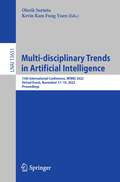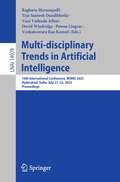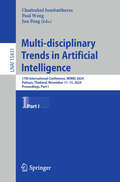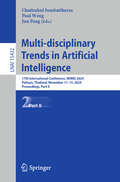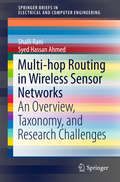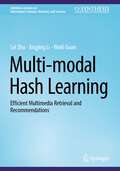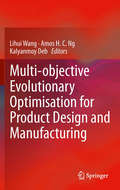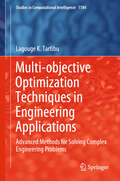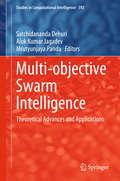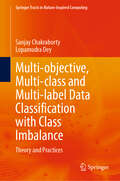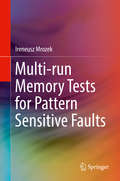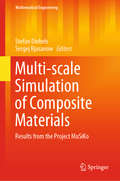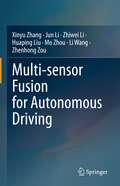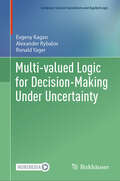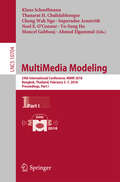- Table View
- List View
Multi-disciplinary Trends in Artificial Intelligence: 15th International Conference, MIWAI 2022, Virtual Event, November 17–19, 2022, Proceedings (Lecture Notes in Computer Science #13651)
by Olarik Surinta Kevin Kam Fung YuenThis book constitutes the refereed proceedings of the 15th International Conference on Multi-disciplinary Trends in Artificial Intelligence, MIWAI 2022, held online on November 17–19, 2022.The 14 full papers and 5 short papers presented were carefully reviewed and selected from 42 submissions.
Multi-disciplinary Trends in Artificial Intelligence: 16th International Conference, MIWAI 2023, Hyderabad, India, July 21–22, 2023, Proceedings (Lecture Notes in Computer Science #14078)
by Pawan Lingras Raghava Morusupalli Teja Santosh Dandibhotla Vani Vathsala Atluri David Windridge Venkateswara Rao KomatiThis book constitutes the refereed proceedings of the 16th International Conference on Multi-disciplinary Trends in Artificial Intelligence, MIWAI 2023, held in Hyderabad, India, during July 21–22, 2023, 2022.The 47 full papers and 24 short papers included in this book were carefully reviewed and selected from 245 submissions. They were organized in topical sections as follows: digital life: an advent of transhumanism; traveling salesperson problem; and centrality measures based heuristics for perfect awareness problem in social networks.
Multi-disciplinary Trends in Artificial Intelligence: 17th International Conference, MIWAI 2024, Pattaya, Thailand, November 11–15, 2024, Proceedings, Part I (Lecture Notes in Computer Science #15431)
by Chattrakul Sombattheera Jun Pang Paul WengThe two-volume set LNAI 15431 and 15432 constitutes the refereed proceedings of the 17th International Conference on Multi-disciplinary Trends in Artificial Intelligence, MIWAI 2024, held in Pattaya, Thailand, during November 11–15, 2024. The 68 full papers presented in these proceedings were carefully reviewed and selected from 147 submissions. The papers focus on various topics in AI and its applications, such as deep learning, machine learning, computer vision, pattern recognition, and natural language processing.
Multi-disciplinary Trends in Artificial Intelligence: 17th International Conference, MIWAI 2024, Pattaya, Thailand, November 11–15, 2024, Proceedings, Part II (Lecture Notes in Computer Science #15432)
by Chattrakul Sombattheera Jun Pang Paul WengThe two-volume set LNAI 15431 and 15432 constitutes the refereed proceedings of the 17th International Conference on Multi-disciplinary Trends in Artificial Intelligence, MIWAI 2024, held in Pattaya, Thailand, during November 11–15, 2024. The 68 full papers presented in these proceedings were carefully reviewed and selected from 147 submissions. The papers focus on various topics in AI and its applications, such as deep learning, machine learning, computer vision, pattern recognition, and natural language processing.
Multi-faceted Deep Learning: Models and Data
by Jenny Benois-Pineau Akka ZemmariThis book covers a large set of methods in the field of Artificial Intelligence - Deep Learning applied to real-world problems. The fundamentals of the Deep Learning approach and different types of Deep Neural Networks (DNNs) are first summarized in this book, which offers a comprehensive preamble for further problem–oriented chapters. The most interesting and open problems of machine learning in the framework of Deep Learning are discussed in this book and solutions are proposed. This book illustrates how to implement the zero-shot learning with Deep Neural Network Classifiers, which require a large amount of training data. The lack of annotated training data naturally pushes the researchers to implement low supervision algorithms. Metric learning is a long-term research but in the framework of Deep Learning approaches, it gets freshness and originality. Fine-grained classification with a low inter-class variability is a difficult problem for any classification tasks. This book presents how it is solved, by using different modalities and attention mechanisms in 3D convolutional networks. Researchers focused on Machine Learning, Deep learning, Multimedia and Computer Vision will want to buy this book. Advanced level students studying computer science within these topic areas will also find this book useful.
Multi-finger Haptic Interaction
by Manuel Ferre Ignacio GalianaMulti-finger Haptic Interaction presents a panorama of technologies and methods for multi-finger haptic interaction, together with an analysis of the benefits and implications of adding multiple-fingers to haptic applications. Research topics covered include: design and control of advanced haptic devices;multi-contact point simulation algorithms;interaction techniques and implications in human perception when interacting with multiple fingers.These multi-disciplinary results are integrated into applications such as medical simulators for training manual skills, simulators for virtual prototyping and precise manipulations in remote environments. Multi-finger Haptic Interaction presents the current and potential applications that can be developed with these systems, and details the systems' complexity. The research is focused on enhancing haptic interaction by providing multiple contact points to the user. This state-of-the-art volume is oriented towards researchers who are involved in haptic device design, rendering methods and perception studies, as well as readers from different disciplines who are interested in applying multi-finger haptic technologies and methods to their field of interest.
Multi-hop Routing in Wireless Sensor Networks
by Shalli Rani Syed Hassan AhmedThis brief provides an overview of recent developments in multi-hop routing protocols for Wireless Sensor Networks (WSNs). It introduces the various classifications of routing protocols and lists the pros and cons of each category, going beyond the conceptual overview of routing classifications offered in other books. Recently many researchers have proposed numerous multi-hop routing protocols and thereby created a need for a book that provides its readers with an up-to-date road map of this research paradigm. The authors present some of the most relevant results achieved by applying an algorithmic approach to the research on multi-hop routing protocols. The book covers measurements, experiences and lessons learned from the implementation of multi-hop communication prototypes. Furthermore, it describes future research challenges and as such serves as a useful guide for students and researchers alike.
Multi-modal Hash Learning: Efficient Multimedia Retrieval and Recommendations (Synthesis Lectures on Information Concepts, Retrieval, and Services)
by Lei Zhu Jingjing Li Weili GuanThis book systemically presents key concepts of multi-modal hashing technology, recent advances on large-scale efficient multimedia search and recommendation, and recent achievements in multimedia indexing technology. With the explosive growth of multimedia contents, multimedia retrieval is currently facing unprecedented challenges in both storage cost and retrieval speed. The multi-modal hashing technique can project high-dimensional data into compact binary hash codes. With it, the most time-consuming semantic similarity computation during the multimedia retrieval process can be significantly accelerated with fast Hamming distance computation, and meanwhile the storage cost can be reduced greatly by the binary embedding. The authors introduce the categorization of existing multi-modal hashing methods according to various metrics and datasets. The authors also collect recent multi-modal hashing techniques and describe the motivation, objective formulations, and optimization steps for context-aware hashing methods based on the tag-semantics transfer.
Multi-objective Evolutionary Optimisation for Product Design and Manufacturing
by Lihui Wang Kalyanmoy Deb Amos H. NgWith the increasing complexity and dynamism in today's product design and manufacturing, more optimal, robust and practical approaches and systems are needed to support product design and manufacturing activities. Multi-objective Evolutionary Optimisation for Product Design and Manufacturing presents a focused collection of quality chapters on state-of-the-art research efforts in multi-objective evolutionary optimisation, as well as their practical applications to integrated product design and manufacturing. Multi-objective Evolutionary Optimisation for Product Design and Manufacturing consists of two major sections. The first presents a broad-based review of the key areas of research in multi-objective evolutionary optimisation. The second gives in-depth treatments of selected methodologies and systems in intelligent design and integrated manufacturing. Recent developments and innovations in multi-objective evolutionary optimisation make Multi-objective Evolutionary Optimisation for Product Design and Manufacturing a useful text for a broad readership, from academic researchers to practicing engineers.
Multi-objective Optimization Techniques in Engineering Applications: Advanced Methods for Solving Complex Engineering Problems (Studies in Computational Intelligence #1184)
by Lagouge K. TartibuThis essential book bridges theory and practice, exploring advanced multi-objective optimization methods applied across engineering fields like manufacturing, renewable energy, and thermal management. This book presents a comprehensive, hands-on guide for engineers, researchers, and students seeking to harness the power of optimization in diverse, real-world scenarios. Through expertly crafted chapters, this book illuminates the strengths of state-of-the-art metaheuristic algorithms—such as the Harris hawk optimization, whale optimization, gray wolf optimization, sunflower optimization, imperialistic competitive optimization, jaya optimization, thermal exchange optimization, grasshopper optimization, and cuckoo search optimization. These algorithms tackle complex, high-dimensional challenges, giving readers invaluable tools to boost performance and efficiency. Case studies breathe life into these methods, showcasing their adaptability in systems with multiple conflicting objectives. Readers will find practical MATLAB and GAMS models, enabling immediate experimentation and application. In an era where efficiency and sustainability are paramount, this book equips engineers to solve today’s toughest optimization problems, making it an indispensable resource for those committed to innovation. Whether focused on energy systems, structural design, or computational mechanics, this book serves as a trusted guide to achieving breakthrough solutions across multiple disciplines.
Multi-objective Swarm Intelligence
by Satchidananda Dehuri Alok Kumar Jagadev Mrutyunjaya PandaThe aim of this book is to understand the state-of-the-art theoretical and practical advances of swarm intelligence. It comprises seven contemporary relevant chapters. In chapter 1, a review of Bacteria Foraging Optimization (BFO) techniques for both single and multiple criterions problem is presented. A survey on swarm intelligence for multiple and many objectives optimization is presented in chapter 2 along with a topical study on EEG signal analysis. Without compromising the extensive simulation study, a comparative study of variants of MOPSO is provided in chapter 3. Intractable problems like subset and job scheduling problems are discussed in chapters 4 and 7 by different hybrid swarm intelligence techniques. An attempt to study image enhancement by ant colony optimization is made in chapter 5. Finally, chapter 7 covers the aspect of uncertainty in data by hybrid PSO.
Multi-objective, Multi-class and Multi-label Data Classification with Class Imbalance: Theory and Practices (Springer Tracts in Nature-Inspired Computing)
by Sanjay Chakraborty Lopamudra DeyThis book explores intricate world of data classification with 'Multi-Objective, Multi-Class, and Multi-Label Data Classification.' This book studies sophisticated methods and strategies for working with complicated data sets, tackling the difficulties of various classes, many objectives, and complicated labelling tasks. This resource fosters a deeper grasp of multi-dimensional data analysis in today's data-driven world by providing readers with the skills and insights needed to navigate the subtleties of modern classification jobs, from algorithmic techniques to practical applications.
Multi-photon Quantum Secure Communication (Signals and Communication Technology)
by Pramode K. Verma Mayssaa El Rifai Kam Wai ChanThis book explores alternative ways of accomplishing secure information transfer with incoherent multi-photon pulses in contrast to conventional Quantum Key Distribution techniques. Most of the techniques presented in this book do not need conventional encryption. Furthermore, the book presents a technique whereby any symmetric key can be securely transferred using the polarization channel of an optical fiber for conventional data encryption. The work presented in this book has largely been practically realized, albeit in a laboratory environment, to offer proof of concept rather than building a rugged instrument that can withstand the rigors of a commercial environment.
Multi-run Memory Tests for Pattern Sensitive Faults
by Ireneusz MrozekThis book describes efficient techniques for production testing as well as for periodic maintenance testing (specifically in terms of multi-cell faults) in modern semiconductor memory. The author discusses background selection and address reordering algorithms in multi-run transparent march testing processes. Formal methods for multi-run test generation and many solutions to increase their efficiency are described in detail. All methods presented ideas are verified by both analytical investigations and numerical simulations.Provides the first book related exclusively to the problem of multi-cell fault detection by multi-run tests in memory testing process;Presents practical algorithms for design and implementation of efficient multi-run tests;Demonstrates methods verified by analytical and experimental investigations.
Multi-scale Simulation of Composite Materials: Results from the Project MuSiKo (Mathematical Engineering)
by Stefan Diebels Sergej RjasanowDue to their high stiffness and strength and their good processing properties short fibre reinforced thermoplastics are well-established construction materials.Up to now, simulation of engineering parts consisting of short fibre reinforced thermoplastics has often been based on macroscopic phenomenological models, but deformations, damage and failure of composite materials strongly depend on their microstructure. The typical modes of failure of short fibre thermoplastics enriched with glass fibres are matrix failure, rupture of fibres and delamination, and pure macroscopic consideration is not sufficient to predict those effects. The typical predictive phenomenological models are complex and only available for very special failures. A quantitative prediction on how failure will change depending on the content and orientation of the fibres is generally not possible, and the direct involvement of the above effects in a numerical simulation requires multi-scale modelling.One the one hand, this makes it possible to take into account the properties of the matrix material and the fibre material, the microstructure of the composite in terms of fibre content, fibre orientation and shape as well as the properties of the interface between fibres and matrix. On the other hand, the multi-scale approach links these local properties to the global behaviour and forms the basis for the dimensioning and design of engineering components. Furthermore, multi-scale numerical simulations are required to allow efficient solution of the models when investigating three-dimensional problems of dimensioning engineering parts.Bringing together mathematical modelling, materials mechanics, numerical methods and experimental engineering, this book provides a unique overview of multi-scale modelling approaches, multi-scale simulations and experimental investigations of short fibre reinforced thermoplastics. The first chapters focus on two principal subjects: the mathematical and mechanical models governing composite properties and damage description. The subsequent chapters present numerical algorithms based on the Finite Element Method and the Boundary Element Method, both of which make explicit use of the composite’s microstructure. Further, the results of the numerical simulations are shown and compared to experimental results.Lastly, the book investigates deformation and failure of composite materials experimentally, explaining the applied methods and presenting the results for different volume fractions of fibres.This book is a valuable resource for applied mathematics, theoretical and experimental mechanical engineers as well as engineers in industry dealing with modelling and simulation of short fibre reinforced composites.
Multi-sensor Fusion for Autonomous Driving
by Jun Li Li Wang Huaping Liu Mo Zhou Zhiwei Li Xinyu Zhang Zhenhong ZouAlthough sensor fusion is an essential prerequisite for autonomous driving, it entails a number of challenges and potential risks. For example, the commonly used deep fusion networks are lacking in interpretability and robustness. To address these fundamental issues, this book introduces the mechanism of deep fusion models from the perspective of uncertainty and models the initial risks in order to create a robust fusion architecture. This book reviews the multi-sensor data fusion methods applied in autonomous driving, and the main body is divided into three parts: Basic, Method, and Advance. Starting from the mechanism of data fusion, it comprehensively reviews the development of automatic perception technology and data fusion technology, and gives a comprehensive overview of various perception tasks based on multimodal data fusion. The book then proposes a series of innovative algorithms for various autonomous driving perception tasks, to effectively improve the accuracy and robustness of autonomous driving-related tasks, and provide ideas for solving the challenges in multi-sensor fusion methods. Furthermore, to transition from technical research to intelligent connected collaboration applications, it proposes a series of exploratory contents such as practical fusion datasets, vehicle-road collaboration, and fusion mechanisms. In contrast to the existing literature on data fusion and autonomous driving, this book focuses more on the deep fusion method for perception-related tasks, emphasizes the theoretical explanation of the fusion method, and fully considers the relevant scenarios in engineering practice. Helping readers acquire an in-depth understanding of fusion methods and theories in autonomous driving, it can be used as a textbook for graduate students and scholars in related fields or as a reference guide for engineers who wish to apply deep fusion methods.
Multi-source, Multilingual Information Extraction and Summarization
by Thierry Poibeau Horacio Saggion Jakub Piskorski Roman YangarberInformation extraction (IE) and text summarization (TS) are powerful technologies for finding relevant pieces of information in text and presenting them to the user in condensed form. The ongoing information explosion makes IE and TS critical for successful functioning within the information society. These technologies face particular challenges due to the inherent multi-source nature of the information explosion. The technologies must now handle not isolated texts or individual narratives, but rather large-scale repositories and streams---in general, in multiple languages---containing a multiplicity of perspectives, opinions, or commentaries on particular topics, entities or events. There is thus a need to adapt existing techniques and develop new ones to deal with these challenges. This volume contains a selection of papers that present a variety of methodologies for content identification and extraction, as well as for content fusion and regeneration. The chapters cover various aspects of the challenges, depending on the nature of the information sought---names vs. events,--- and the nature of the sources---news streams vs. image captions vs. scientific research papers, etc. This volume aims to offer a broad and representative sample of studies from this very active research field.
Multi-spectral and Intelligent Sensing (SpringerBriefs in Computer Science)
by Xiaoming Tao Lu Sun Liting Wang Wentao ShenThis book provides a concise overview of intelligent technologies for vision and sensing, with a particular focus on their applications in various multispectral configurations, including safety monitoring in rural areas. Within the realm of intelligent perception and contemporary healthcare, the book emphasizes the real-time monitoring, analysis, and prediction of vital signals using biomedical optical sensors. This approach aims to offer more adaptable and personalized services within the medical health management domain. Furthermore, the book delves into the comprehensive comprehension of physiological signals and additional data sources, such as environmental and motion data. The goal is to enhance the breadth and depth of data analysis, providing more integrated support for the life and health sector. Additionally, the book explores the implementation of edge intelligence algorithms at the sensor level to enable real-time analysis, enhancing the efficiency of sensor data processing and utilization. Detailed explanations of the configuration and deployment of an active vision camera system featuring an integrated edge algorithm are provided to elucidate the coordination and communication mechanisms of edge intelligence technology across multiple edge devices. A specific application case is then presented—the universal camera jamming system—which underscores the benefits of intelligent sensing fusion for tasks such as attitude and position recognition, as well as self-feedback excitation jamming. The book underscores the pervasive and seamless integration of smart sensing in both current and future lifestyles, spanning from active vision cameras to diverse applications across multiple spectrums. Its insights are poised to stimulate innovation and application within the realms of smart vision and sensing, including a comprehensive analysis of future healthcare paradigms.
Multi-valued Logic for Decision-Making Under Uncertainty (Computer Science Foundations and Applied Logic)
by Ronald Yager Evgeny Kagan Alexander RybalovMulti-valued and fuzzy logics provide mathematical and computational tools for handling imperfect information and decision-making with rational collective reasoning and irrational individual judgements. The suggested implementation of multi-valued logics is based on the uninorm and absorbing norm with generating functions defined by probability distributions. Natural extensions of these logics result in non-commutative and non-distributive logics. In addition to Boolean truth values, these logics handle subjective truth and false values and model irrational decisions. Dynamics of decision-making are specified by the subjective Markov process and learning – by neural network with extended Tsetlin neurons. Application of the suggested methods is illustrated by modelling of irrational economic decisions and biased reasoning in the wisdom-of-the-crowd method, and by control of mobile robots and navigation of their groups. Topics and features: Bridges the gap between fuzzy and probability methods Includes examples in the field of machine-learning and robots’ control Defines formal models of subjective judgements and decision-making Presents practical techniques for solving non-probabilistic decision-making problems Initiates further research in non-commutative and non-distributive logics The book forms a basis for theoretical studies and practice of decision-making under uncertainty and will be useful for computer scientists and mathematicians interested in multi-valued and fuzzy logic, as well as for engineers working in the field of data mining and data analysis.
Multi-variant User Interfaces in E-commerce: A Practical Approach to UI Personalization (Progress in IS)
by Adam WasilewskiThis book focuses on the personalisation of the user interface in e-commerce based on collected data on customer behaviour. While product recommendation systems are widely used for this purpose today, they do not allow for a comprehensive adaptation of the layout to different user groups. The proposed approach is based on the conclusion that since e-commerce customers are different, the user interface should also be different. To make this possible, several components need to be combined, which together allow the design of the online shop to be automatically or expertly adapted to the customer's choices and behaviour. It presents and discusses a framework that allows data to be collected, processed and used to optimise UI variants for generated customer segments. The proposed approach has been verified in practice and further developed on this basis, so that the reader is presented with a solution that is not riddled with 'baby age' problems, and the limitations and challenges identified are described and commented on in detail. Typical e-commerce systems currently have a single UI for all customers. The implementation of multi-variant UIs therefore represents an opportunity for companies to create a marketing advantage by addressing the personalisation trends in e-commerce.The book is intended for those responsible for developing e-commerce platform and user interfaces for web-based systems, as well as individuals interested in practical applications of machine learning in business.
MultiMedia Modeling
by Moncef Gabbouj Yo-Sung Ho Klaus Schoeffmann Thanarat H. Chalidabhongse Chong Wah Ngo Supavadee Aramvith Noel E. O’Connor Ahmed ElgammalThe two-volume set LNCS 10704 and 10705 constitutes the thoroughly refereed proceedings of the 24th International Conference on Multimedia Modeling, MMM 2018, held in Bangkok, Thailand, in February 2018. Of the 185 full papers submitted, 46 were selected for oral presentation and 28 for poster presentation; in addition, 5 papers were accepted for Multimedia Analytics: Perspectives, Techniques, and Applications, 12 extended abstracts for demonstrations ,and 9 accepted papers for Video Browser Showdown 2018. All papers presented were carefully reviewed and selected from 185 submissions.
MultiMedia Modeling
by Moncef Gabbouj Yo-Sung Ho Klaus Schoeffmann Thanarat H. Chalidabhongse Chong Wah Ngo Supavadee Aramvith Noel E. O’Connor Ahmed ElgammalThe two-volume set LNCS 10704 and 10705 constitutes the thoroughly refereed proceedings of the 24th International Conference on Multimedia Modeling, MMM 2018, held in Bangkok, Thailand, in February 2018. Of the 185 full papers submitted, 46 were selected for oral presentation and 28 for poster presentation; in addition, 5 papers were accepted for Multimedia Analytics: Perspectives, Techniques, and Applications, 12 extended abstracts for demonstrations ,and 9 accepted papers for Video Browser Showdown 2018. All papers presented were carefully reviewed and selected from 185 submissions.
MultiMedia Modeling
by Benoit Huet Qi Tian Nicu Sebe Guo-Jun Qi Richang Hong Xueliang LiuThe two-volume set LNCS 9516 and 9517 constitutes the thoroughly refereed proceedings of the 22nd International Conference on Multimedia Modeling, MMM 2016, held in Miami, FL, USA, in January 2016. The 32 revised full papers and 52 poster papers were carefully reviewed and selected from 117 submissions. In addition 20 papers were accepted for five special sessions out of 38 submissions as well as 7 demonstrations (from 11 submissions) and 9 video showcase papers. The papers are organized in topical sections on video content analysis, social media analysis, object recognition and system, multimedia retrieval and ranking, multimedia representation, machine learning in multimedia, and interaction and mobile. The special sessions are: good practices in multimedia modeling; semantics discovery from multimedia big data; perception, aesthetics, and emotion in multimedia quality modeling; multimodal learning and computing for human activity understanding; and perspectives on multimedia analytics.
MultiMedia Modeling
by Laurent Amsaleg Gylfi Þór Guðmundsson Cathal Gurrin Björn Þór Jónsson Shin’ichi SatohThe two-volume set LNCS 10132 and 10133 constitutes the thoroughly refereed proceedings of the 23rd International Conference on Multimedia Modeling, MMM 2017, held in Reykjavik, Iceland, in January 2017. Of the 149 full papers submitted, 36 were selected for oral presentation and 33 for poster presentation; of the 34 special session papers submitted, 24 were selected for oral presentation and 2 for poster presentation; in addition, 5 demonstrations were accepted from 8 submissions, and all 7 submissions to VBS 2017. All papers presented were carefully reviewed and selected from 198 submissions. MMM is a leading international conference for researchers and industry practitioners for sharing new ideas, original research results and practical development experiences from all MMM related areas, broadly falling into three categories: multimedia content analysis; multimedia signal processing and communications; and multimedia applications and services.
MultiMedia Modeling
by Laurent Amsaleg Gylfi Þór Guðmundsson Cathal Gurrin Björn Þór Jónsson Shin’ichi SatohThe two-volume set LNCS 10132 and 10133 constitutes the thoroughly refereed proceedings of the 23rd International Conference on Multimedia Modeling, MMM 2017, held in Reykjavik, Iceland, in January 2017. Of the 149 full papers submitted, 36 were selected for oral presentation and 33 for poster presentation; of the 34 special session papers submitted, 24 were selected for oral presentation and 2 for poster presentation; in addition, 5 demonstrations were accepted from 8 submissions, and all 7 submissions to VBS 2017. All papers presented were carefully reviewed and selected from 198 submissions. MMM is a leading international conference for researchers and industry practitioners for sharing new ideas, original research results and practical development experiences from all MMM related areas, broadly falling into three categories: multimedia content analysis; multimedia signal processing and communications; and multimedia applications and services.
